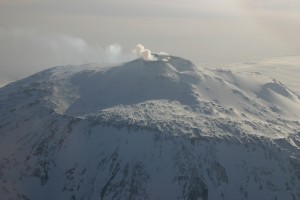22 December 2014
Picture Perfect and Water Wise: Images May Someday Predict the Hazards of Volcanic Gas
Posted by kwheeling
By James Urton

Gassy Mount Erebus served as a proving ground for Girona’s efforts to measure water vapor content of degassed plumes.
Credit: Jeaneeem
Earlier this year, superheated water within Japan’s Mount Ontake triggered a hydrothermal explosion. Scientists monitoring the volcano had seen no signs of impending danger. The resulting steam-triggered eruption killed 57 people.
Clusters of earthquakes often precede major eruptions of lava and ash. The same is not true for smaller steam-triggered eruptions of gas like the Ontake event. But those are the sorts of events that Társilo Girona would like to predict, and he believes that cameras may be the key.
Girona, who recently completed his doctoral degree at Nanyang Technological University and the Earth Observatory of Singapore, described a new technique using photographs and computer models that could measure water vapor content of gaseous plumes more accurately. Girona described the new technique Thursday at the American Geophysical Union’s Fall Meeting in San Francisco.
Many volcanoes periodically emit plumes of gases through vents, an event known as “degassing.” Girona believes that it could be possible to forecast events like the Ontake eruption by monitoring a volcano’s degassing behavior. Unfortunately, it is difficult to decipher of the details of degassing, including one of the most important components of gas plumes: water vapor.
“Water vapor is the major component of most gas plumes from volcanoes,” said Girona.
Current methods to look at water vapor in degassed plumes are blunt instruments, and often require going dangerously close to volcanic vents. “They’re just not good to explain the dynamics of degassing,” said Girona.
Instead of taking direct readings from a plume, Girona examined how water vapor in a plume scatters sunlight. He then developed a model that would calculate the brightness of plumes in high-resolution photographs, and use this brightness value to determine the amount of water vapor within it. He tested his model using photographs of laboratory-generated plumes with known amounts of water vapor. Brighter plumes held more water vapor, and his calculations accurately estimated the amount of water vapor in each plume.
Girona then turned his model to photographs of a plume from a real volcano, Antarctica’s Mount Erebus. “It’s a persistently gassy volcano,” he noted.
After adjusting his calculations to account for image background, the sun’s position in the sky, temperature, pressure and humidity, Girona saw that water vapor levels in the plume overlapped well with levels of another gas common to volcanic plumes, sulfur dioxide.
However, Girona also discovered something surprising about the Erebus plume. Sections of the plume contained sulfur dioxide gas, but no water. This might indicate that degassing does not release uniformly mixed gases from the volcanic interior. Girona theorizes that bubbles of each gas might build up in distinct sections of the interior, and then escape at different times. It is possible that changes in these degassing patterns might forewarn of impending eruptions, he said.
Girona hopes this photographic technique could someday make it safer and easier to monitor plumes, as well as produce more accurate data for predicting volcanic hazards. He plans to adjust his model for other volcanoes, especially those that belch out thicker and more dangerous plumes.
– James Urton is a science communication graduate student at UC Santa Cruz


 GeoSpace is a blog on Earth and space science, managed by AGU’s Public Information staff. The blog features posts by AGU writers and guest contributors on all sorts of relevant science topics, but with a focus on new research and geo and space sciences-related stories that are currently in the news.
GeoSpace is a blog on Earth and space science, managed by AGU’s Public Information staff. The blog features posts by AGU writers and guest contributors on all sorts of relevant science topics, but with a focus on new research and geo and space sciences-related stories that are currently in the news.